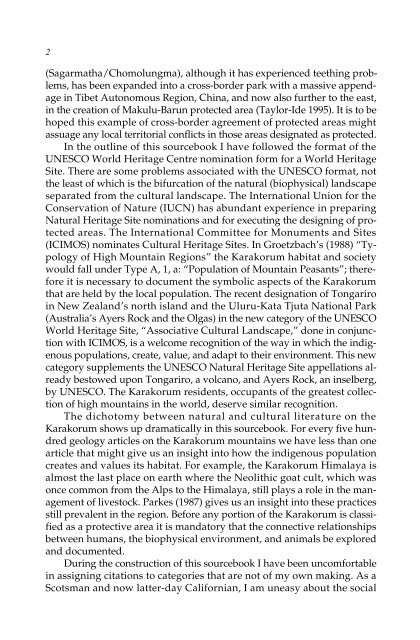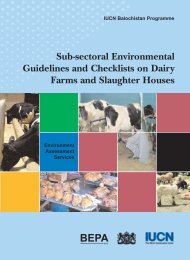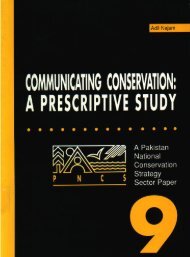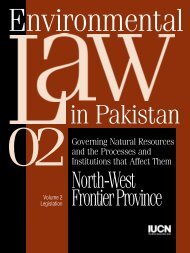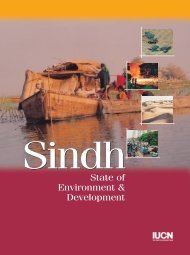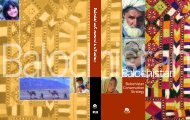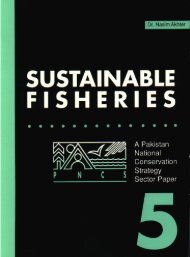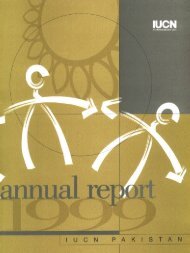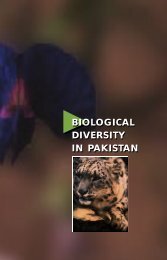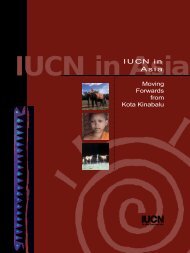Nigel JR Allan - IUCN - Pakistan
Nigel JR Allan - IUCN - Pakistan
Nigel JR Allan - IUCN - Pakistan
You also want an ePaper? Increase the reach of your titles
YUMPU automatically turns print PDFs into web optimized ePapers that Google loves.
2<br />
(Sagarmatha/Chomolungma), although it has experienced teething problems,<br />
has been expanded into a cross-border park with a massive appendage<br />
in Tibet Autonomous Region, China, and now also further to the east,<br />
in the creation of Makulu-Barun protected area (Taylor-Ide 1995). It is to be<br />
hoped this example of cross-border agreement of protected areas might<br />
assuage any local territorial conflicts in those areas designated as protected.<br />
In the outline of this sourcebook I have followed the format of the<br />
UNESCO World Heritage Centre nomination form for a World Heritage<br />
Site. There are some problems associated with the UNESCO format, not<br />
the least of which is the bifurcation of the natural (biophysical) landscape<br />
separated from the cultural landscape. The International Union for the<br />
Conservation of Nature (<strong>IUCN</strong>) has abundant experience in preparing<br />
Natural Heritage Site nominations and for executing the designing of protected<br />
areas. The International Committee for Monuments and Sites<br />
(ICIMOS) nominates Cultural Heritage Sites. In Groetzbach’s (1988) “Typology<br />
of High Mountain Regions” the Karakorum habitat and society<br />
would fall under Type A, 1, a: “Population of Mountain Peasants”; therefore<br />
it is necessary to document the symbolic aspects of the Karakorum<br />
that are held by the local population. The recent designation of Tongariro<br />
in New Zealand’s north island and the Uluru-Kata Tjuta National Park<br />
(Australia’s Ayers Rock and the Olgas) in the new category of the UNESCO<br />
World Heritage Site, “Associative Cultural Landscape,” done in conjunction<br />
with ICIMOS, is a welcome recognition of the way in which the indigenous<br />
populations, create, value, and adapt to their environment. This new<br />
category supplements the UNESCO Natural Heritage Site appellations already<br />
bestowed upon Tongariro, a volcano, and Ayers Rock, an inselberg,<br />
by UNESCO. The Karakorum residents, occupants of the greatest collection<br />
of high mountains in the world, deserve similar recognition.<br />
The dichotomy between natural and cultural literature on the<br />
Karakorum shows up dramatically in this sourcebook. For every five hundred<br />
geology articles on the Karakorum mountains we have less than one<br />
article that might give us an insight into how the indigenous population<br />
creates and values its habitat. For example, the Karakorum Himalaya is<br />
almost the last place on earth where the Neolithic goat cult, which was<br />
once common from the Alps to the Himalaya, still plays a role in the management<br />
of livestock. Parkes (1987) gives us an insight into these practices<br />
still prevalent in the region. Before any portion of the Karakorum is classified<br />
as a protective area it is mandatory that the connective relationships<br />
between humans, the biophysical environment, and animals be explored<br />
and documented.<br />
During the construction of this sourcebook I have been uncomfortable<br />
in assigning citations to categories that are not of my own making. As a<br />
Scotsman and now latter-day Californian, I am uneasy about the social


